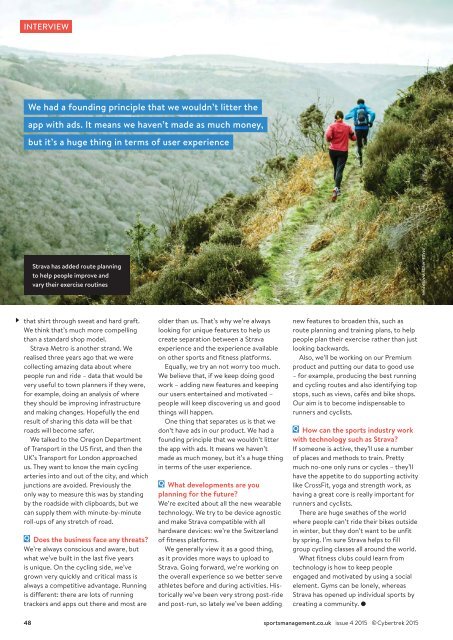EDDIE IZZARD
SM_issue4_2015
SM_issue4_2015
Create successful ePaper yourself
Turn your PDF publications into a flip-book with our unique Google optimized e-Paper software.
INTERVIEW<br />
We had a founding principle that we wouldn’t litter the<br />
app with ads. It means we haven’t made as much money,<br />
but it’s a huge thing in terms of user experience<br />
Strava has added route planning<br />
to help people improve and<br />
vary their exercise routines<br />
IMAGE: ANDY WATERMAN<br />
that shirt through sweat and hard graft.<br />
We think that’s much more compelling<br />
than a standard shop model.<br />
Strava Metro is another strand. We<br />
realised three years ago that we were<br />
collecting amazing data about where<br />
people run and ride – data that would be<br />
very useful to town planners if they were,<br />
for example, doing an analysis of where<br />
they should be improving infrastructure<br />
and making changes. Hopefully the end<br />
result of sharing this data will be that<br />
roads will become safer.<br />
We talked to the Oregon Department<br />
of Transport in the US first, and then the<br />
UK’s Transport for London approached<br />
us. They want to know the main cycling<br />
arteries into and out of the city, and which<br />
junctions are avoided. Previously the<br />
only way to measure this was by standing<br />
by the roadside with clipboards, but we<br />
can supply them with minute-by-minute<br />
roll-ups of any stretch of road.<br />
Does the business face any threats?<br />
We’re always conscious and aware, but<br />
what we’ve built in the last five years<br />
is unique. On the cycling side, we’ve<br />
grown very quickly and critical mass is<br />
always a competitive advantage. Running<br />
is different: there are lots of running<br />
trackers and apps out there and most are<br />
older than us. That’s why we’re always<br />
looking for unique features to help us<br />
create separation between a Strava<br />
experience and the experience available<br />
on other sports and fitness platforms.<br />
Equally, we try an not worry too much.<br />
We believe that, if we keep doing good<br />
work – adding new features and keeping<br />
our users entertained and motivated –<br />
people will keep discovering us and good<br />
things will happen.<br />
One thing that separates us is that we<br />
don’t have ads in our product. We had a<br />
founding principle that we wouldn’t litter<br />
the app with ads. It means we haven’t<br />
made as much money, but it’s a huge thing<br />
in terms of the user experience.<br />
What developments are you<br />
planning for the future?<br />
We’re excited about all the new wearable<br />
technology. We try to be device agnostic<br />
and make Strava compatible with all<br />
hardware devices: we’re the Switzerland<br />
of fitness platforms.<br />
We generally view it as a good thing,<br />
as it provides more ways to upload to<br />
Strava. Going forward, we’re working on<br />
the overall experience so we better serve<br />
athletes before and during activities. Historically<br />
we’ve been very strong post-ride<br />
and post-run, so lately we’ve been adding<br />
new features to broaden this, such as<br />
route planning and training plans, to help<br />
people plan their exercise rather than just<br />
looking backwards.<br />
Also, we’ll be working on our Premium<br />
product and putting our data to good use<br />
– for example, producing the best running<br />
and cycling routes and also identifying top<br />
stops, such as views, cafés and bike shops.<br />
Our aim is to become indispensable to<br />
runners and cyclists.<br />
How can the sports industry work<br />
with technology such as Strava?<br />
If someone is active, they’ll use a number<br />
of places and methods to train. Pretty<br />
much no-one only runs or cycles – they’ll<br />
have the appetite to do supporting activity<br />
like CrossFit, yoga and strength work, as<br />
having a great core is really important for<br />
runners and cyclists.<br />
There are huge swathes of the world<br />
where people can’t ride their bikes outside<br />
in winter, but they don’t want to be unfit<br />
by spring. I’m sure Strava helps to fill<br />
group cycling classes all around the world.<br />
What fitness clubs could learn from<br />
technology is how to keep people<br />
engaged and motivated by using a social<br />
element. Gyms can be lonely, whereas<br />
Strava has opened up individual sports by<br />
creating a community. ●<br />
48<br />
sportsmanagement.co.uk issue 4 2015 © Cybertrek 2015


